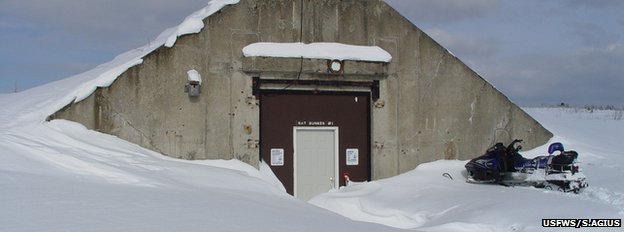 A Cold War bunker at Loring Air Force Base in Maine that has been converted into a winter haven for bats. Image from: BBC News, USFWS/S. Agius
A Cold War bunker at Loring Air Force Base in Maine that has been converted into a winter haven for bats. Image from: BBC News, USFWS/S. Agius
Scientists in Maine have converted two Cold War bunkers at Loring Air Force Base into winter havens for bats in an effort to protect the animals from the fungus that causes white nose syndrome. What is nice about using a man-made space is that they can actually clean up the area as opposed to trying to kill the fungus in a cave where multiple species of fungi may be affected, thereby disrupting the micro-ecosystem. The winter survival rate is not very high so far, only 9 out of 30 of the animals survived the stress of capture, transport, and captivity. The researchers have added roosts and closed captioning televisions to the bunkers to help study the animals. I hope their efforts at creating man-made safe havens for these bats works as this fungus has killed up to 6.7 million bats to date, and is continuing to spread.
For more information on these bunkers, visit BBC News.
For prior posts on white nose syndrome and bats:
North American Bats Face Possible Endangerment
White Nose Syndrome - Revisited
White Nose Syndrome and Evaporative Water Loss
Does Ketosis Occur During Hibernation?

Bats are famous for their sensitive hearing - so why do they need closed-caption tv?
I think he meant closed circuit television. Although, personally, I'd like a local bat channel.
Botton-line: even nuclear escalation between opposing ideologies has its plus sides :)